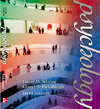 |
1 |  | 
The psychological viewpoint that favors the study of how the mind organizes perceptions, processes information, and interprets experiences is known as: |
|  | A) | cognitive psychology |
|  | B) | clinical psychology |
|  | C) | biopsychology |
|  | D) | industrial psychology |
 |
 |
2 |  | 
A _________ concept is formed by identifying the specific features possessed by all things that the concept applies to. |
|  | A) | prototype |
|  | B) | logical |
|  | C) | natural |
|  | D) | trial and error |
 |
 |
3 |  | 
A problem-solving rule or procedure that, when followed step by step, assures that a correct solution will be found is known as: |
|  | A) | mental set |
|  | B) | trial and error |
|  | C) | algorithm |
|  | D) | insight |
 |
 |
4 |  | 
A(n) ________ represents a general principle that guides problem solving, though it does not guarantee a correct solution. |
|  | A) | mental set |
|  | B) | heuristic |
|  | C) | algorithm |
|  | D) | insight |
 |
 |
5 |  | 
The cognitive process known as _________ thinking occurs when an individual freely considers a variety of potential solutions to artistic, literary, scientific, or practical problems. |
|  | A) | heuristic |
|  | B) | creative |
|  | C) | convergent |
|  | D) | divergent |
 |
 |
6 |  | 
The inability to realize that a problem can be solved by using a familiar object in an unusual way is likely due to a mental set known as: |
|  | A) | functional fixedness |
|  | B) | divergent thinking |
|  | C) | convergent thinking |
|  | D) | creative thinking |
 |
 |
7 |  | 
In decision making, the _______ represents the tendency to estimate the probability of an event by how easily relevant instances of it come to mind. |
|  | A) | representative heuristic |
|  | B) | availability heuristic |
|  | C) | framing effects |
|  | D) | functional fixedness |
 |
 |
8 |  | 
Patient Jones is told that an operation has a 10 percent chance of failure, whereas patient Smith is told that the same operation has a 90 percent chance of success. If Jones chooses not to have the surgery, while Smith chooses to have the surgery, to what psychological phenomenon could you attribute this outcome? |
|  | A) | representative heuristic |
|  | B) | availability heuristic |
|  | C) | framing effects |
|  | D) | functional fixedness |
 |
 |
9 |  | 
The characteristic of language marked by the ability to refer to objects and events that are not present is: |
|  | A) | semanticity |
|  | B) | generativity |
|  | C) | displacement |
|  | D) | phonology |
 |
 |
10 |  | 
The set of rules that governs the proper use and combination of language symbols is |
|  | A) | grammar |
|  | B) | semanticity |
|  | C) | generativity |
|  | D) | phonology |
 |
 |
11 |  | 
The smallest meaningful units of language are: |
|  | A) | syntax |
|  | B) | morphemes |
|  | C) | phonemes |
|  | D) | semantics |
 |
 |
12 |  | 
The phenomenon of _______ describes the application of grammatical rules without making necessary exceptions to them. |
|  | A) | telegraphic speech |
|  | B) | underextension |
|  | C) | overregularization |
|  | D) | holophrastic speech |
 |
 |
13 |  | 
The use of single words to represent whole phrases or sentences is known as: |
|  | A) | telegraphic speech |
|  | B) | underextension |
|  | C) | overregularization |
|  | D) | holophrastic speech |
 |
 |
14 |  | 
Speech marked by reliance on nouns and verbs, while omitting other parts of speech, including articles and prepositions represents: |
|  | A) | telegraphic speech |
|  | B) | underextension |
|  | C) | overregularization |
|  | D) | holophrastic speech |
 |
 |
15 |  | 
_________ grammar involves the rules by which languages generate surface structures from deep structures, and deep structures from surface structures. |
|  | A) | syntax |
|  | B) | semanticity |
|  | C) | generativity |
|  | D) | transformational |
 |



 2002 McGraw-Hill Higher Education
2002 McGraw-Hill Higher Education

 2002 McGraw-Hill Higher Education
2002 McGraw-Hill Higher Education